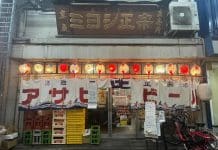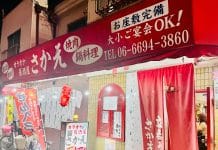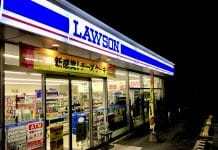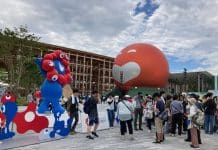
WELCOME TO Part III of three articles, an ultimate guide to fishing in the Osaka South Bay Area! Part 1, a guide to beginners, and Part II and III, an introduction to 8 ultimate fishing locations and points for veteran anglers to land big fish in Osaka Bay. In Part II, we covered the north-bay. Gear up! We’re hitting the south-bay in Part III, our final contribution to this ultimate guide! The “List of Target Fish” will be linked to within this article for reference here. (second heading in).
Early spring will see a surge of warmth soon. The days become longer, warmer, and brighter. With this change comes a spike in the fishes’ appetites as more food supply shows up in the bay from the many tributaries and estuaries. Breeding time begins. Many large “commuter fish” make their way into the bay to prey on younger fish. In turn the anglers’ chance to prey on these agile hunters is also at hand. Remember the old adage: sometimes it takes a small fish to catch a large one! Shake off your cabin fever! The clear water of Osaka’s south-bay awaits you!! Fish on!
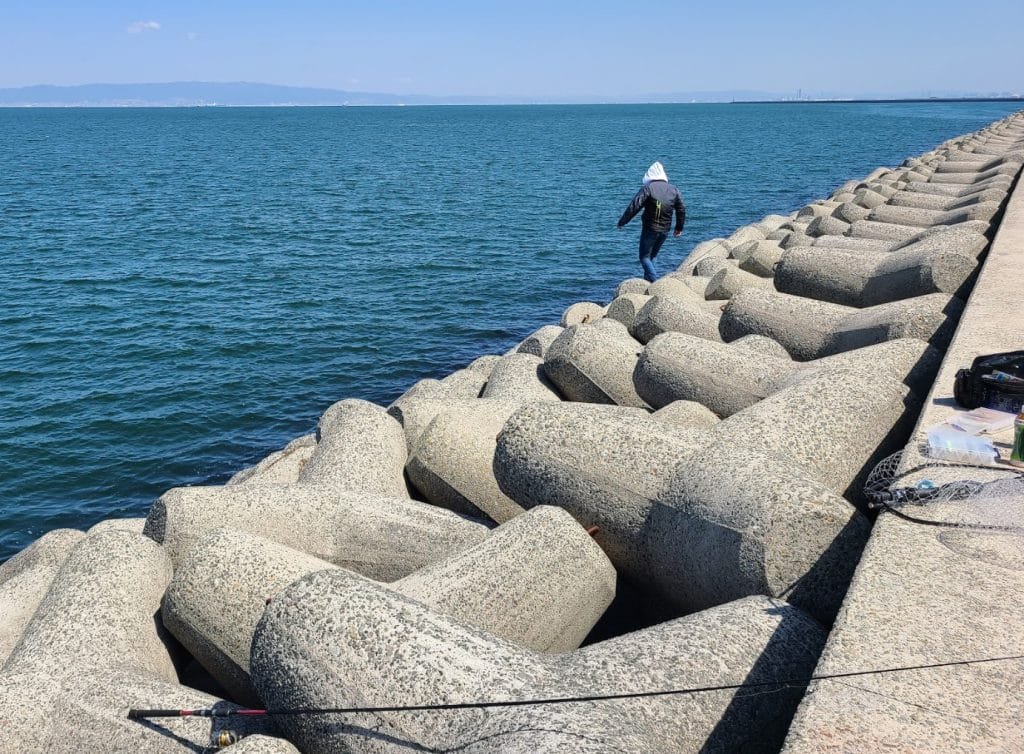
Table of Contents
Location #5: Kaizuka Jinkoutou -inner/outer reaches on island; Tetrahedron and Quay Fishing
Kaizuka. A playground on the veritable fish garden that is Osaka South Bay. Easy to reach, free to drive onto, accessible to all who pursue both small AND big fish. It is also an absolute favorite haven to my fishing partner, Koichi “Kouchan” Ozaki, local Tsuri- Baka (fish-crazy angler!), GAMAKATSU BRAND aficionado and gear sampler, expert angler, and best friend. Fishing pals for over twenty years now, Kaizuka is a playground wherein each spot holds its own story; its own rules of play. Where we know the game like the back of our hands.
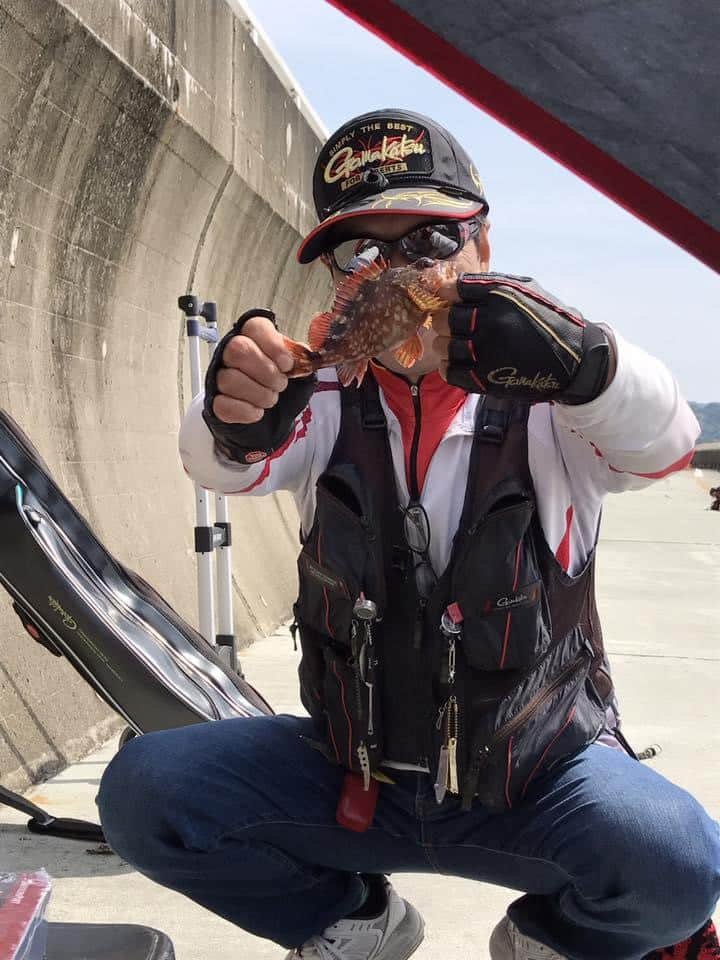
aficionado, and expert angler presents a Meibaru “Scorpion Rockfish”.
In Part II, recall the inked Gyotaku print of the Chinu on a white sheet? That was his fine catch of over fifty cm.! A standing rule abides that a fishing shop, in this case, Fishing Max, will print it in ink for you so long as it is 50cm and above! Sadly that day, my catch came in at only 47cm. All the pummeling and attempts to stretch the carcass to fifty centimeters came to no avail short of running over it with the truck tire! No ink sheet for me that day!


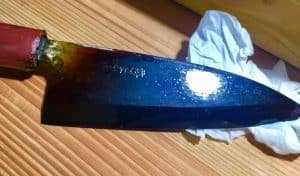



Kaizuka Jinkou-tou is an artificial island connected to the main shoreline by two bridges, Nishiki Ohashi and Kaizuka Ohashi. Kaizuka once housed the Japan Car Ferry Co. and the Marine Express Ferry Port. It was here at the old docking spot in fact, where Kouchan and I first met, fishing side by side (and have been ever since!).
Massive sections of the island are now used for storage of everything from trucks to cement telephone poles to great industrial bales of electrical cable. The twin ferries and the respective company- and its glorious history- worth its own write up in its own right- are long a thing of the past here. Nevertheless, this island —for mostly uncrowded access and various spots to try out free— is still our fave.
Featuring open areas of cement revetment that span the whole north/north-eastern perimeter both before and after the old Kaizuka ferry staging area, the north end ‘Long Pier’ as well as westward facing tetrahedron access area with its ‘L’-shaped jetty, and ‘The channel’ to the south provide a wealth of spots to move to.

The north-western part of the island sports a massive stretch of tetrahedron water breaks. Like jacks stacked one upon the other, these offer casting access to open bay and its depths as well as ‘fishing the holes’ in the gaps between the tetrahedrons. This is a HOT spot for Chinu, black sea bream, cutlass fish in late summer thru autumn, and large-scale sea bass. There is also a Marine Seaside Paradise Park- known for its ‘colored sand’ beach on the island’s south-west side that has a pay parking, clean restrooms, and areas for picnicking, barbecuing, and fishing.
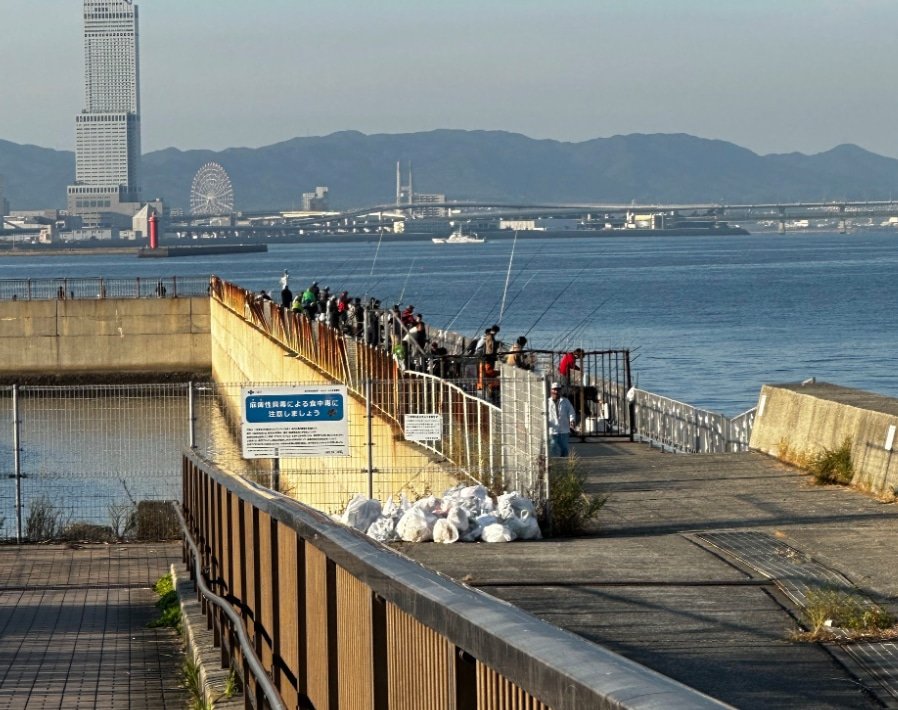
The jetty, as shown above, is found at the end off the tetrahedron water break. It encases a rectangular area of side water called the “Pool”, a breeding area for Yellowfin, Hamachi, and is off- limits to fishing. The jetty itself is long and spacious. Parking down on the road and under the revetment wall is free for first come-first serve! DO NOT park on the main road as your vehicle will be towed!
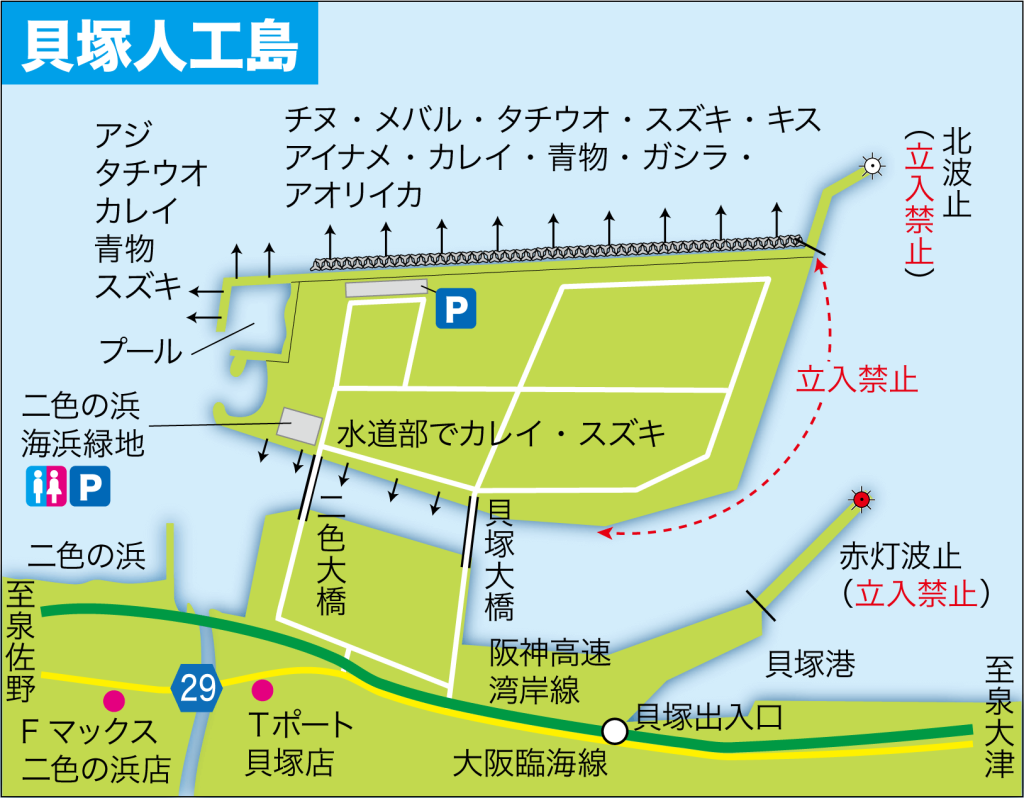
Whereas the tetrahedron side of the man-made island channel spans the whole north-west side running roughly south to north , the complete south/ south-east side is spanned by the channel running roughly west to east. At the south side island under both bridges mentioned above runs the ‘Between island and mainland’ channel. The channel flows between the man-made island and the main shore, as seen in the above picture is wide, sandy-bottomed, and good for Halibut, Kisu, or Japanese Whiting, Mackerel, Sardines, Cutlass fish, Seabass, and Bream. When the tide rises, the water flows in from the west at a rapid pace. When its tide reverts to low tide, the water recedes from east to west. Like a river, the speed of the water running thru at peak tides is fairly fast. Either side of the channel offer various species of fish both big and small to fish for. It is also home to a large octopi population! Recommended targets will show below in the details. In autumn, cutlass fish can be had here to the end of December.

Though not mentioned in the main target list, concerning fishing in between the tetrahedron pylons, various fishes such as green rock fish, scorpion fish, octopus, and others can be fished for with mini rods and bait dropped into holes between pylons!
The expansive tetrahedron shoreline is at least 6km. in length and has various access points. Many points are accessed by makeshift ladders that allow one to scale the sea wall and thereby, get out on the tetrahedrons as well as continue further down the sea wall.
NOTE OF CAUTION: Experienced Anglers know firsthand the art of foot placement, balance, and a steady hand on all gear. Nevertheless, accidents and falls do happen. IT IS NOT A RECOMMENDATION OF NOR/BY THE CITY OF OSAKA FOR ANGLERS TO PUT THEMSELVES AT RISK BY FISHING ATOP THE TETRAHEDRON PYLONS. Nor however, is it prohibited. Warning signs implore would be anglers to exercise extreme caution and BE VIGILANT AT ALL TIMES. One false slip, a twisted ankle, a fall off a tall sea wall on one side or worse, between tetrahedron pylons on the other could prove fatal. To get caught particularly upside down in a fall between pylons in a rising tide could mean being unable to climb out let alone be found. Always travel with a partner, never alone while so close to the sea.
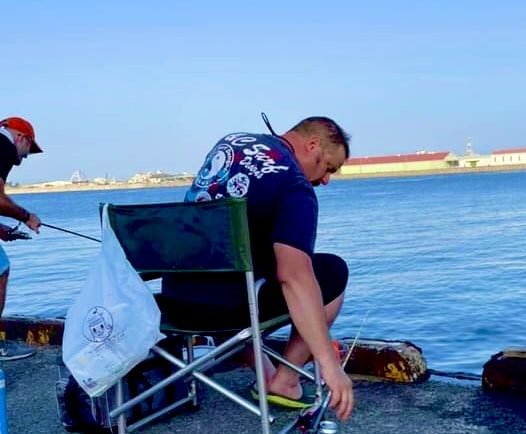
Point #1: The Old Kaizuka Ferry Revetment Wall -east end of the channel.
DETAILS:
Cross Kaizuka Ohashi Bridge, turn right toward the eastern part of the island.
Turn south and drive until you see cars parked along the channel.
Access the revetment area at the far east end.
Areas on southern and eastern revetments have closed to the public over the years. Access opposite the old ferry port by turning north-east and accessing north revetment gate.
Main sport fish to target are tiny sardines and Spanish mackerel to use as live bait.


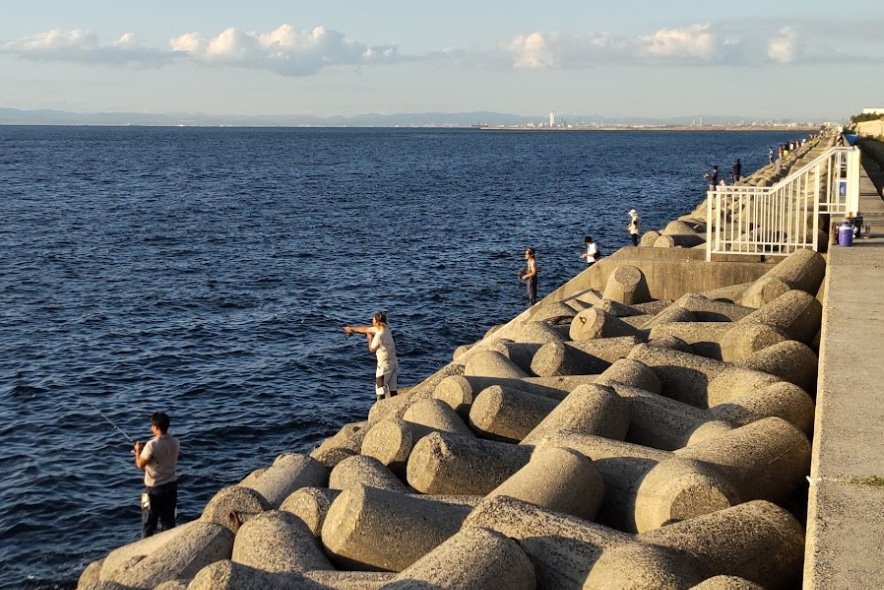






Fish to be had are Black Bream, Chinu, Yellowfin, Cutlass fish, Spanish Mackerel, Horse Makerel, Sardines, and – as an extra – Kare, mini-Halibut! Park and fish! Most areas you can drive up for nearby water access. Especially good for families/ children.

Location #6: FISHING HOUSE- Izumi-Sano Inner Port Access/ Shokuhin Kombinat (Food processing factory complex)
Point #1 and 2: “The Drum Cans” (East and West-Shokuhin Kombinat Harbor)
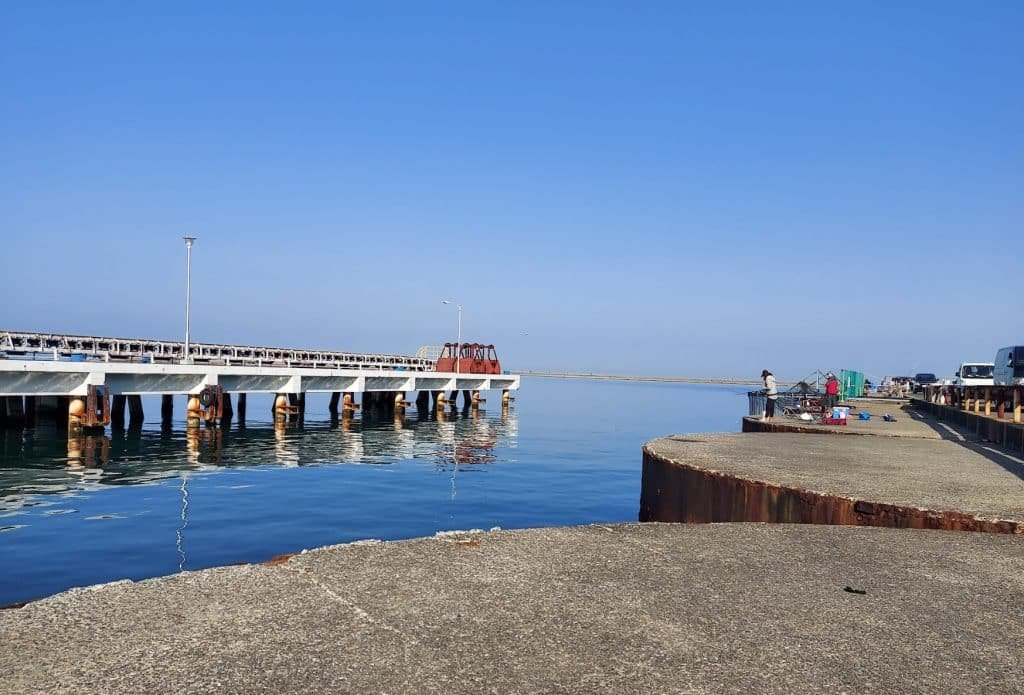
A very popular spot for anglers of all types, and long a favorite of the author! Drive up access to deep water is the lure of this place. There are three sides that make up the port shaped like an inverted ’T’: The two sides of the opening of the harbor both east and west, then the south side wall -inner harbor that spreads left to right.

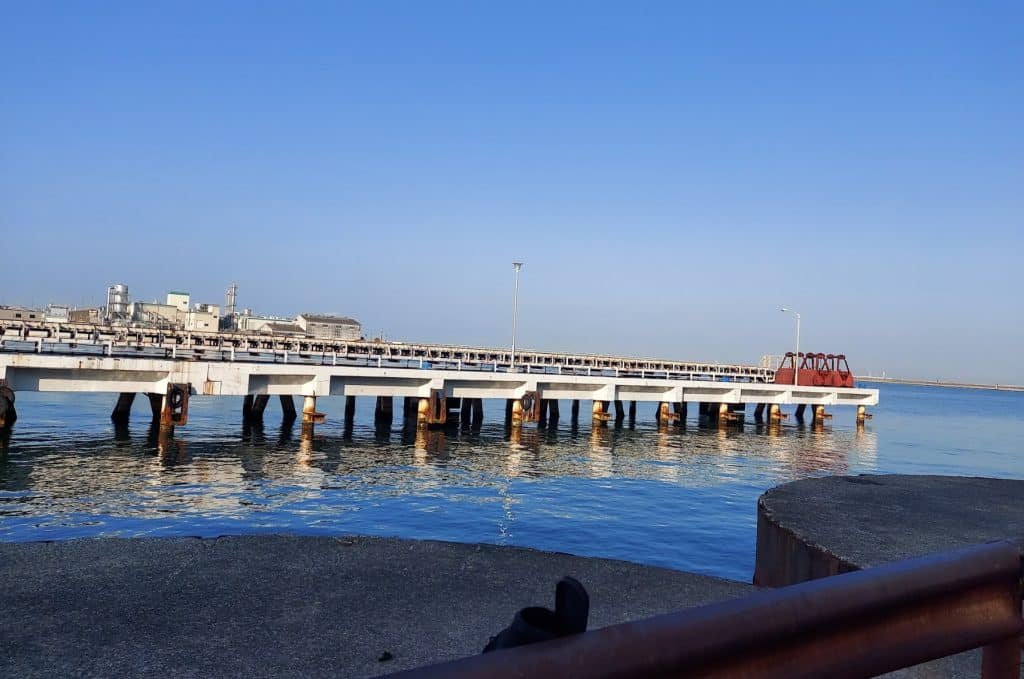
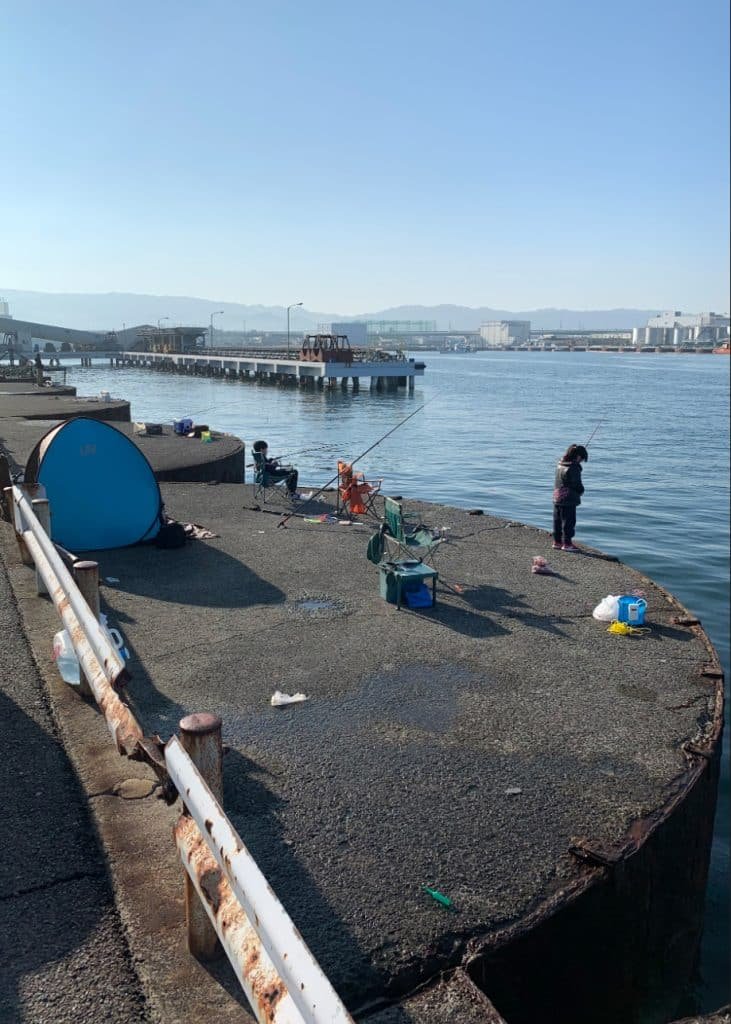



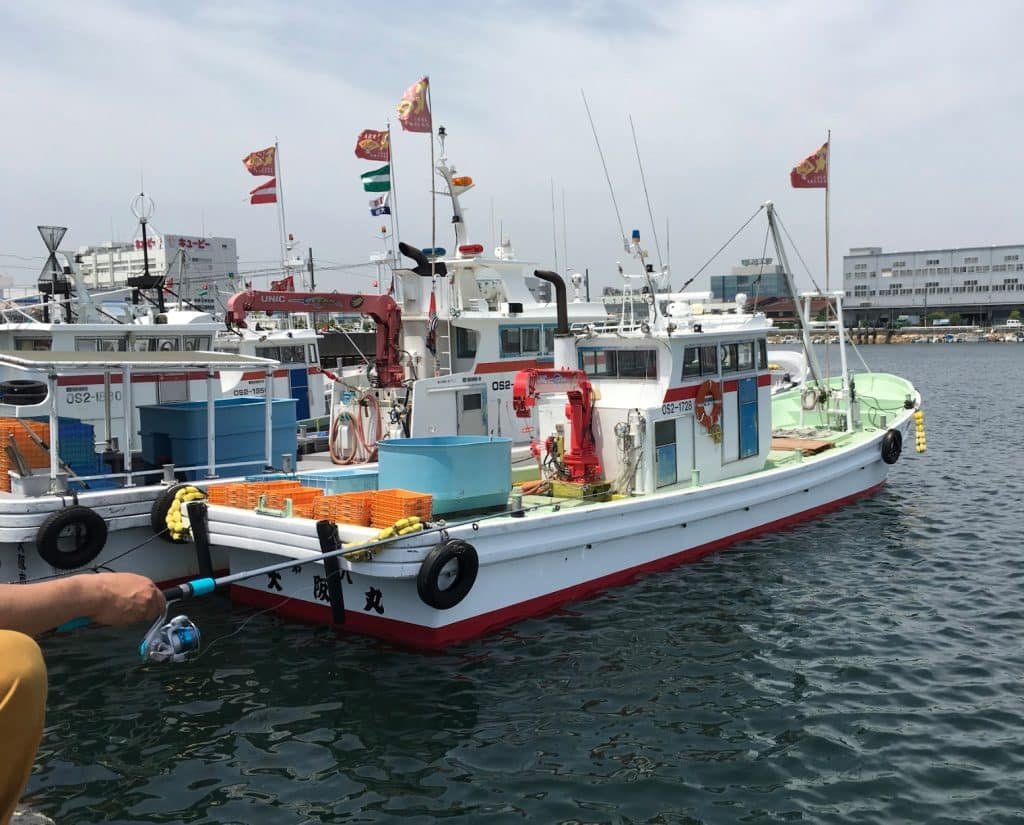
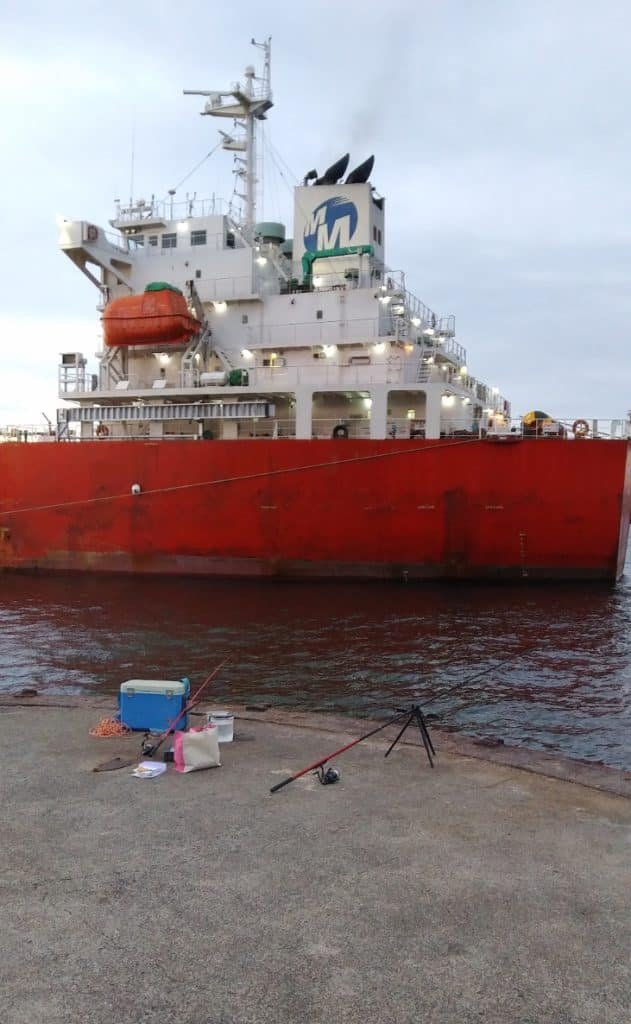

The west and east sides of the harbor are constructed artificial revetment atop huge drum cans, thus the name of this area. It is very well known by this name. Plenty of different fish are had in the harbor and even more outside of it. At the north extreme end is a wall with ladders leading to a long, long wall of tetrahedrons from which anglers cast out depending on the season and what fish they are after. My recommendation is to check with the local fishing store on what is booming in that harbor and when, especially concerning the tetrahedron perimeter outside the harbor entrance.



On average however, Horse Mackerel (above) and young Sea bass, Hane, (above) abound in the harbor along with Octopus, black Sea Bream, pink Sea Bream, Scorpion Fish, , sardines, and red surumeika, squid ‘with a hat’. Bait fishing or lure is most widely used with attention to casting out at the end of the revetment with large floats and catching full size (30-40cm) Spanish mackerel.
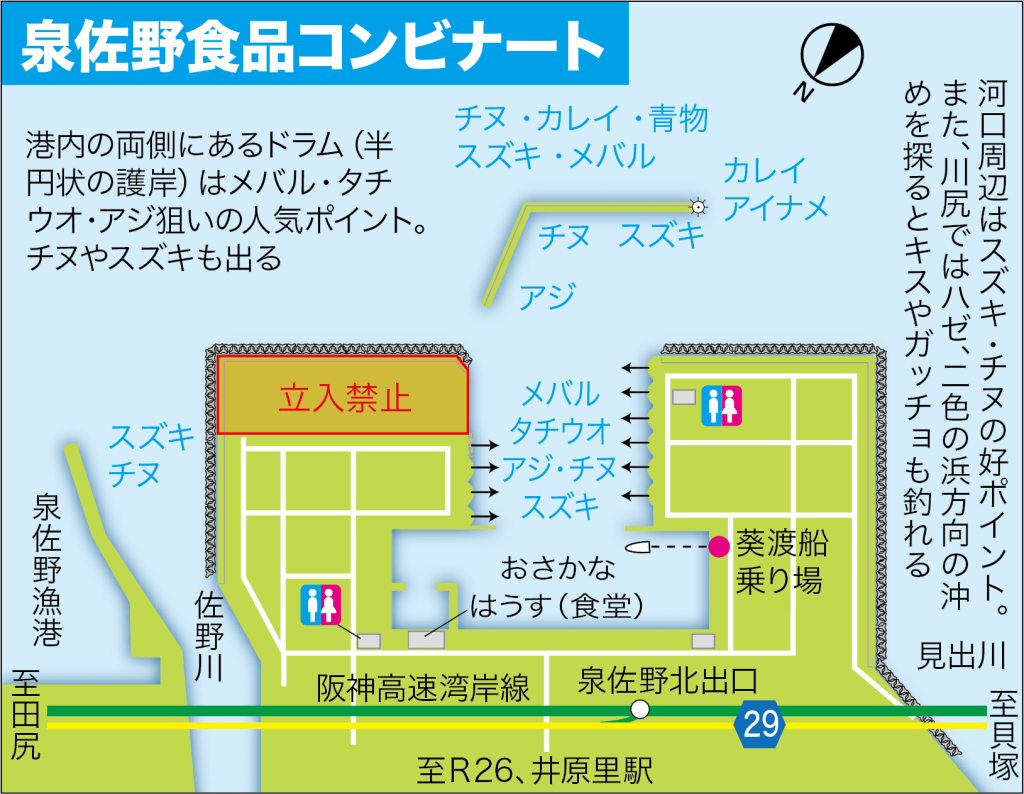
Point # 3: The “Fishing House”, Inner Harbor, and South Revetment
It is this south side that houses a long-time favorite icon called the ‘Fishing House’ cafe-restaurant- now just a relic. It s located in the bottom of the inverted ‘T’ shaped harbor and runs the whole span of the inner bay clear to the puppy dog shaped building seen above which is a fairly new addition to the yacht harbor. Points can be found anywhere around this inner bay area. Hane, yearling sea bass can be caught in droves from spring through fall. Tilapia is also a fish on the rise here. No-one is sure how they came to populate the area. Bait fishing is recommended.



DETAILS:
Revetment is a free fishing zone although it houses many ships coming to fill their ships from the chutes of the nearby fertilizer factory.
Free access, park where you fish!!!!
Toilet facilities available/ No other facilities available. A ramen or hot-steamed potato truck often make rounds. Great on a cold evening!
No guard rails nor fall prevention scaffolding in place. KEEP KIDS and gear BACK from the edge. Avoid tripping over gear.
Very crowded on weekends and holidays.
Various kinds of fish of varying size to be caught here.
Revetment is 3 meters to water surface depending on the tide. DO NOT FALL IN. There is no definite way out and a strong current exists. Have a rope on hand for emergencies. Wear a flotation device.
9-10 meters deep, deeper at the mouth of the harbor.
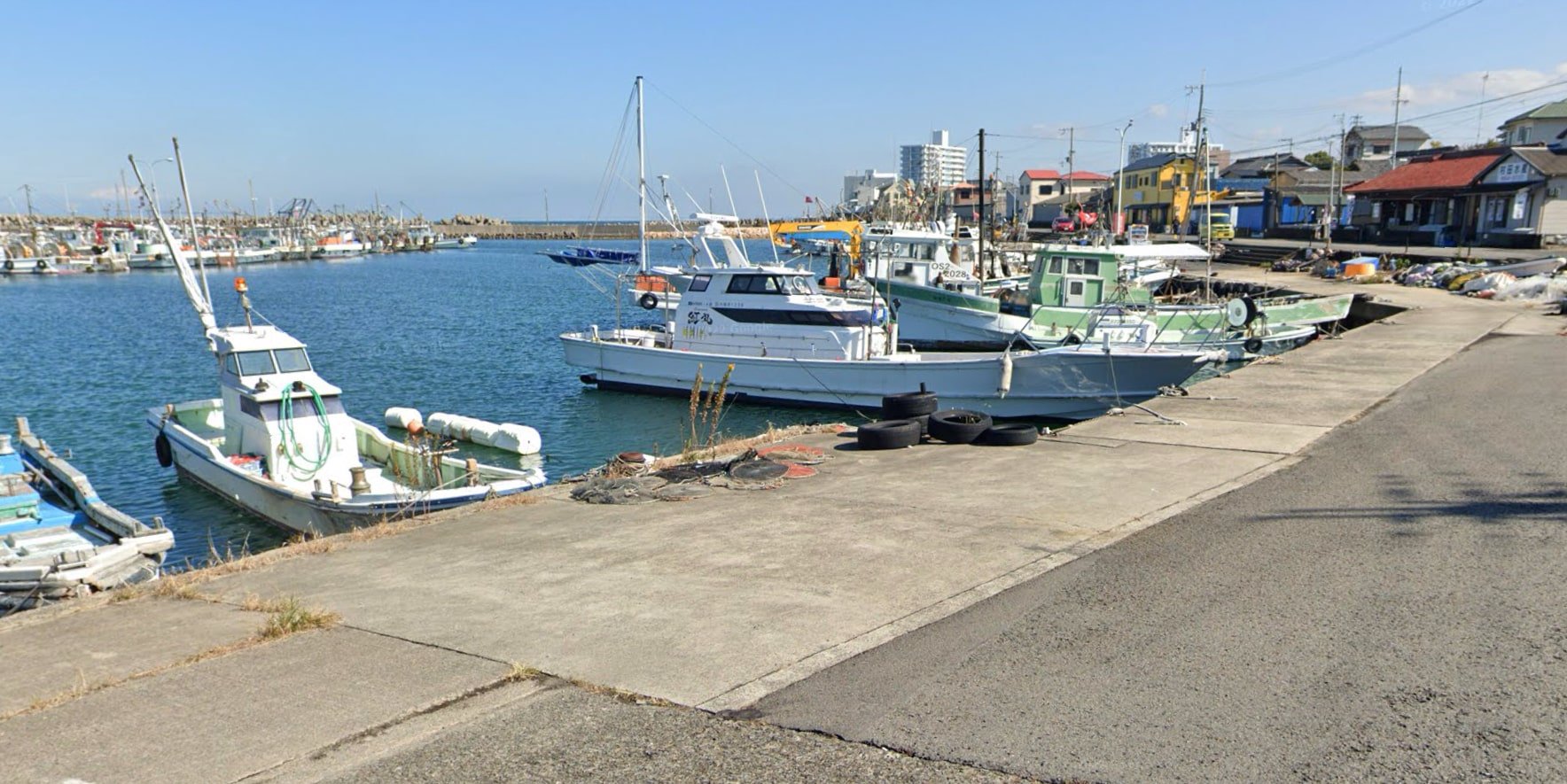
Location #7: Sennan, Tannowa/ Misaki Seaside Port / North Seawall Tetrahedrons
The farther you head south, the clearer the water, the more beautiful the view, the more old time fishing villages begin to emerge as part of the seaside landscape. Gone are the factories and revetment walls upon which Osaka’s industrial sprawl has come to roost. A feeling of nostalgia envelops, as though one has stepped back forty years. Indeed, time seems to have stopped here. A day on this part of the bay is like a time capsule to the past; a simpler, slower going way of life. A big spot for Ika, squid- the three types listed in the table- especially Aoorika, the tastiest and biggest of all squid types in Osaka Bay! Fall is the biggest time of their migration, and most are caught by jigging squid lures on a 2–4-meter squid or bass EGGING rod with P-line or ‘squid thread’ line of 6-8 lb. test. Diagram below will show the rig most commonly used.
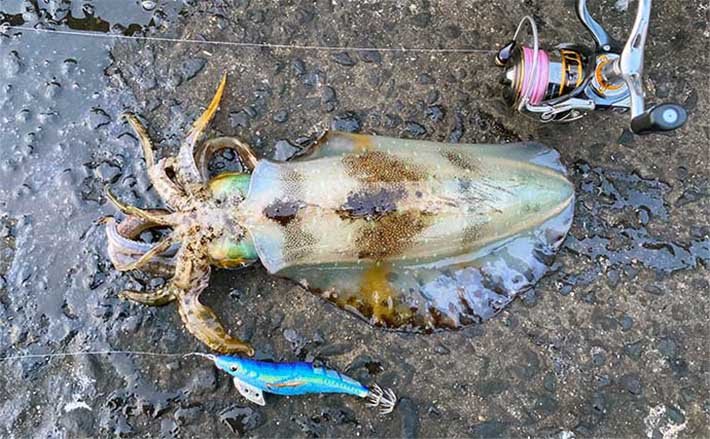


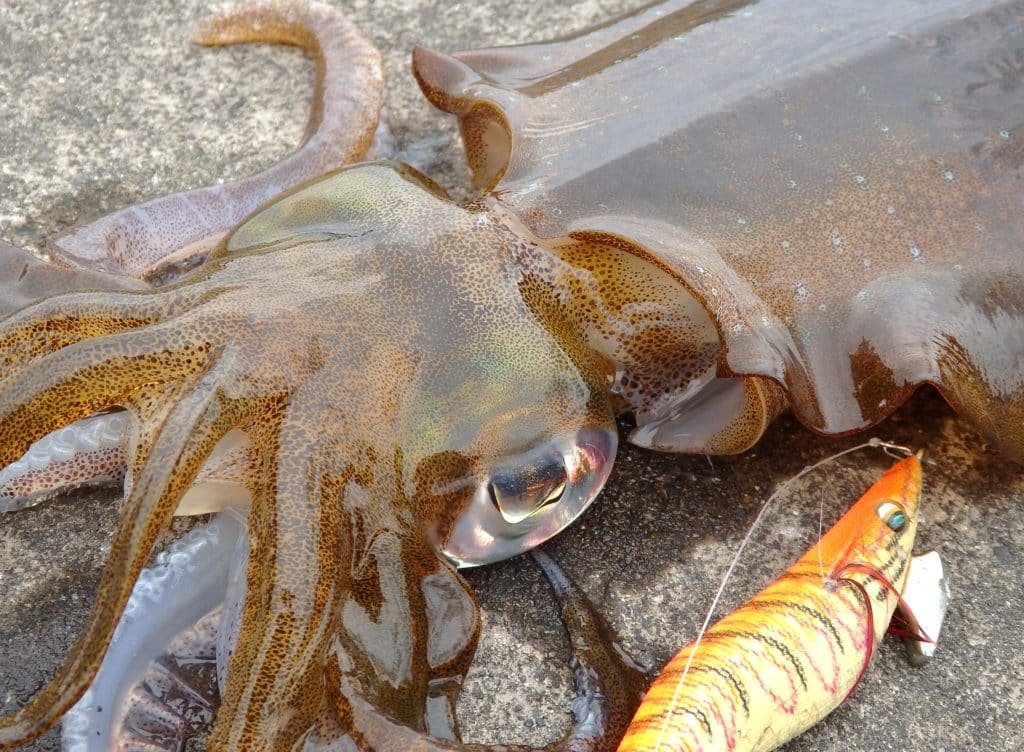
There is an old Japanese adage that if you can tell a squid male and female apart, keep a sharp eye: IF you catch the female first, move quick to disengage the lure, and toss the SAME lure in the exact same spot. Nine times out of ten the male will still be there, sort of dumbfounded. He will attack the lure and impale himself on it! Perhaps same as man, he will fight for his woman! However, if you catch the male first, waste no time in even trying for the female, she will be long gone!



Using the same kind of rod can often net you Scorpion Rockfish if casting small runner lure also to be had if the live bait is right, aka blood worms, flounder. The water is sandy, rocky with pebbles, and shallow. Fifty meters out however, is the drop off to deep water and a sandy bottom. Here is where the flounder are of the 30- 40 cm size!



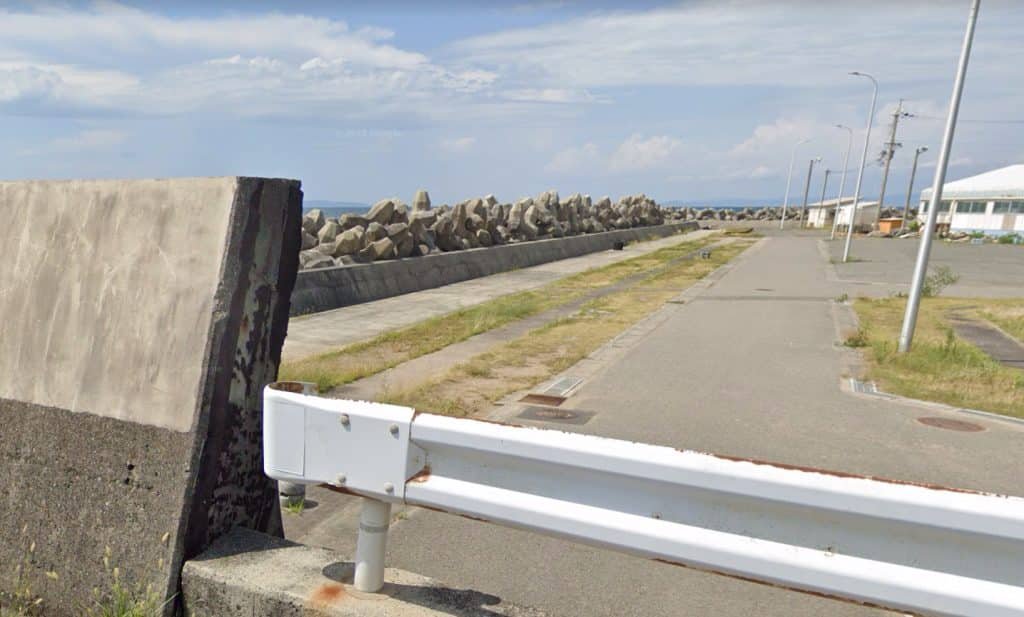


DETAILS:
Fall is the best season here. SQUID should be your target.
Aoorika squid can be had here in the 50 cm. range!
Squid fishing is a process of egging or jigging a long shrimp-like lure in such a way as to imitate the up/down motion of a swimming or injured shrimp.
Jigging action should entice the squid to reach out and grab (and entangle) its tentacled arms onto the many barbs at the tail of the lure.
If it pulls- you pull! (But not too hard so as to rip the lure barbs through the delicate flesh of the squid, loosing it from your line.) Reel it in slowly, gently, and steadily.
No facilities. Park within the harbor but out of the way.
Telescopic net, wet gear, and flotation vest a strong recommendation.
Egging rod in the 6-8 ft. size with multiple squid lures in mostly shades of pink, orange, light blue, and navy blue recommended.
Use cools in sun/ warm colors in cloud.
Location #8: Misaki Koen Ura- Surf Casting

Point #1. Ura Misaki Koen
There are rock and cement piers set out like ramps onto the sea within 100m of one another. Only one-2 feet above sea level, one can get wet. Waiters and floatable vest, wet weather gear recommended. Fall and spring season is a good season to cast for squid here as well as lure fishing for sea bass. Flounder are also caught here using blood worms. Many folks come to collect Asari clams when the tide is out. The water is very clear here and clean.
DETAILS:
Quays are barely 50cm. above water, enough to walk out on and improve ones cast.
Standing at the tip end of the quay is a recipe for getting wet or slipping on the wet rocks.
Cast then make your way back down the quay with your bale open. Jig from shore.
No facilities and little parking along the roadside.
Easily the most beautiful fishing spot in Osaka!
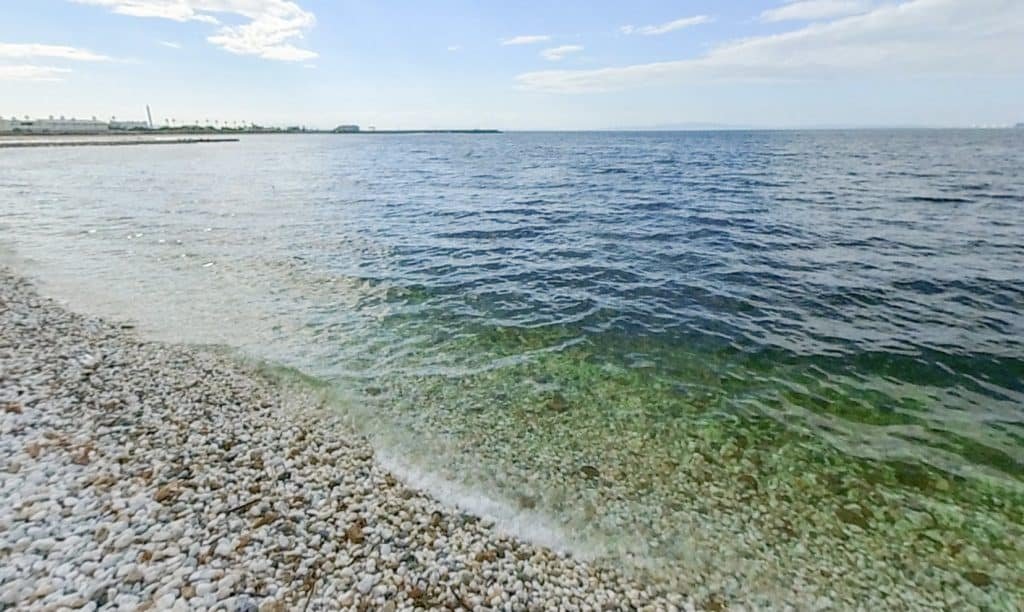

We here at Osaka.com hope you enjoyed this ultimate guide to secret locales for both beginning and veteran anglers and their families and friends. Hope to see you out on the bay! Fish on!!





